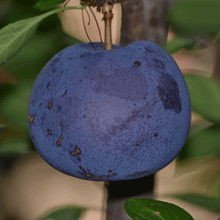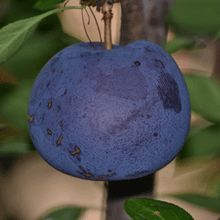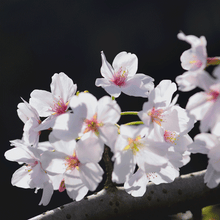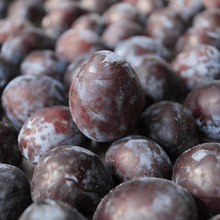Frost-Friendly Plum Tree
Dubbed the California plum tree of the pf-midwest, Black Ice plum trees can withstand cold weather up to -30 degrees Fahrenheit! This means your tree won’t die well below freezing, so you can continue to reap the reward of sweet, juicy plums without ever having to worry about replanting after a cold winter.
Add Surprising Interest to Your Landscape
This Lydecker plum tree’s branches spread out and weep over the trunk creating a stunning architectural display to muse over every season. In the spring, little white, waxy flowers bloom against lush green foliage. In late July, big, purplish-black plums with red and yellow flesh will fill the boughs of your tree.
Get Extremely LARGE Plums
These plums aren’t just pretty — they’re big, too. Black Ice plums are the size of tennis balls!
The Black Ice Plum tree is the love child of a California cherry plum tree and a large Japanese plum tree called P. Salicina. The Black Ice plum inherited its size from the Japanese variety making it one of the largest hybrid plums.
The Black Ice is a little piece of human ingenuity in your own yard!
Perhaps the JUICIEST Plum You’ve Ever Tasted
The California cherry plum gives this black plum its sweet flavor. That’s why it’s known as a dessert plum.
Imagine baking your own plum pies and tarts. You’ll only need a couple of plums per recipe since they’re so big, which means you’ll have plenty more to bake and share with your neighbors, friends, and family.
Simple to Sustain, Little to Manage,
Black Ice Plum trees persevere in cold weather making them an exceptional selection if you live in areas where temperatures dip below freezing. These plum trees are also easy to maintain. They only require full to partial sun light and well-drained, fertile soil.
The Black Ice is also a dwarf plum tree, so it will take up less space in your yard. You could even plant it in a container.
Let the bees put in the work pollinating your trees, so you can sit back and enjoy the fruits of their labor while also seeing the spectacle of nature unfold before your eyes.
Very Popular at Farmers Markets
If the best farmers like this plum, you will too! The Black Ice plum tree is well known as a farmers market favorite. Impress your friends by having one of the most sought after plum trees around.
No need to rush the crowd and paw over plums when you can pick plenty at your leisure in your own yard!
Prepare for a fruitful summer by planting one of these black beauties yourself. Order now!
Planting & Care
Seasonal Information
California style plum bred for colder climates. Hardy in zones 4-8. Its naturally compact growth habit makes management easier. Its canopy is low, about 2’ off the ground. The mature height is about 8-12’ and its spread can be as much as 10’. Plan accordingly when spacing. Plant spacing should be between 12-15’.
Location/Exposure
Location should include full sun and if possible, sheltered from excessive wind exposure. South or West facing spots out of the wind are best. Plums are tolerant of urban pollution issues and will do well in city environments.
Avoid planting in low lying areas where late spring frosts are more common.
Pollination Requirements:
Black Ice Plum is a Japanese-American hybrid. It is self-infertile, so requires another cultivar of compatible genetic material with the same bloom-time so they can cross-pollinate. Top choices are “Toka”(Bubblegum), “Superior”, or “American” Plum. Cross pollinating plums should be planted within 25’ of each other.
Soil Preferences
It’s not particular regarding pH, slightly acid or slightly alkaline is fine. Black Ice will do best in well drained soils, with average to evenly moist soil conditions. Starting with good organic matter helps with water retention, aeration, and provides nutrients. The plum will not tolerate standing water for extended periods of time.
Planting – Pots/Containers
Plums are not typically grown indoors or in containers in general because of their growth habit and because of their self-infertile nature. If growing in pots or containers, be sure to provide enough space for the roots to grow into, and plan to root prune once the tree is established in the largest pot you want it in.
Planting -- Garden
Make sure that temperatures are mild and all chance of frost has passed before planting outdoors. Remove the plant from the container it came in and remove any circling roots by laying the ball on its side and removing them with shears. Dig a hole that is a few inches deeper and wider than the spread of the roots after you removed them from the container and prepared them. Make a small mound in the center of the bottom of the hole and set the tree on top of the mound. Spread the roots away from the trunk without excessively bending them. Backfill around the roots, firming the soil and watering as you go to remove air pockets. Fill the hole to the soil level the tree was grown in without covering the container’s soil with new soil. Stake if warranted due to wind exposure or tipping potential.
Watering
Water young trees heavily during the first growing season to help promote growth, then water regularly. Best to water deeply at the soil line, let the soil dry out slightly then water again. Do not let the soil become fully dry. Water well into the early autumn, so as to have good soil moisture through the winter.
Fertilization
Do not fertilize young trees until they have set fruit. Once there is good fruit set, plan for regular fertilizing throughout the year. Use about a pound of Calcium Nitrate per tree; or 1.5 lbs of 10-10-10. Less fertilizer is needed if the soil medium has good organic matter from compost. Cut back fertilizer if there are signs of salt burn (burn on the leaf edges), and water the tree well after applying. Change the analysis to less nitrogen in the early fall and winter, or just avoid fertilizers altogether at that time so as to not encourage new growth during those seasons.
Weed Control
Mulch can be used, but keep it away from the trunk of the trees and don’t mulch too deep. Otherwise keep weeds at bay by mowing or weeding.







